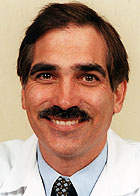School of Medicine heart surgeons report that by adding a simple 10- to 20-second step to an operative procedure, they achieved a significant improvement in the outcome for the surgical treatment of atrial fibrillation (AF).

Reporting in the April issue of the Journal of Thoracic and Cardiovascular Surgery, the surgeons describe an enhancement to the Cox-Maze procedure, a surgical procedure that redirects wayward electrical impulses causing AF by creating precisely placed scars, or ablations, in the heart muscle. The Cox-Maze procedure is highly effective, offering the best long-term cure rate for persistent atrial fibrillation.
The surgeons added one ablation to the series of ablations typically made during the Cox-Maze procedure, and that short step improved how well patients did after surgery. As a result, they recommend using this extra ablation in all patients undergoing the procedure.
“The single additional ablation creates what we call a box lesion,” said Ralph J. Damiano Jr., M.D., the John M. Shoenberg Professor of Surgery and chief of cardiac surgery. “The box lesion surrounds and electrically isolates the pulmonary veins and the posterior left atrial wall from the rest of the left atrium. Our study shows excellent success when using the box lesion, and we recommend it for any patient with long-standing atrial fibrillation.”
AF is the most common irregular heart rhythm and affects more than 2 million people in the United States. During atrial fibrillation, the upper chambers (atria) of the heart beat rapidly and quiver instead of contracting, drastically reducing the amount of blood they pump. AF can cause fatigue, shortness of breath, exercise intolerance, heart palpitations and stroke.
Led by Damiano, also a cardiac surgeon at Barnes-Jewish Hospital, the WUSTL surgeons revolutionized AF treatment in 2002 by helping develop a radiofrequency clamp that creates the ablation lines needed to reroute electrical impulses in the heart. The clamp directs radiofrequency energy into the heart muscle and creates a full-thickness scar.
The radiofrequency clamp procedure is quicker and easier than the original “cut and sew” Cox-Maze procedure, which was developed by James Cox, M.D., at WUSTL in 1987. The original procedure relied on a complex series of 10 incisions in the heart muscle, creating a “maze” to channel errant electrical impulses where they should go. In the newer version, called Cox-Maze IV, most of these incisions were replaced by radiofrequency ablations, reducing the operation from an average of 90 minutes to about 30 minutes.
The current study involved two groups of patients with AF. One group underwent radio-frequency ablation-assisted Cox-Maze IV procedures without a box lesion and the other with a box lesion. The box lesion group had a 48 percent lower occurrence of atrial flutter and fibrillation in the first weeks after surgery. These patients also had shorter hospital stays (nine days on average) than patients who had the standard Cox-Maze IV procedure (an average stay of 11 days).
Three months after surgery, 95 percent of patients who had the box lesion had no signs of AF, while only 85 percent of the patients who had the standard Cox-Maze IV procedure were free from AF. By six and 12 months postsurgery, all of the patients in the box lesion group were free from AF compared with 90 percent of the other group, although that difference was not statistically significant.
“We also saw that the use of antiarrhythmic drugs was lower after three and six months in those who received a box lesion,” Damiano said. “These drugs can have serious side effects, and if patients can stop using them, they often feel better. Overall, the use of the box lesion set was associated with shorter hospitalization, fewer medications and reduced recurrence of atrial fibrillation.”